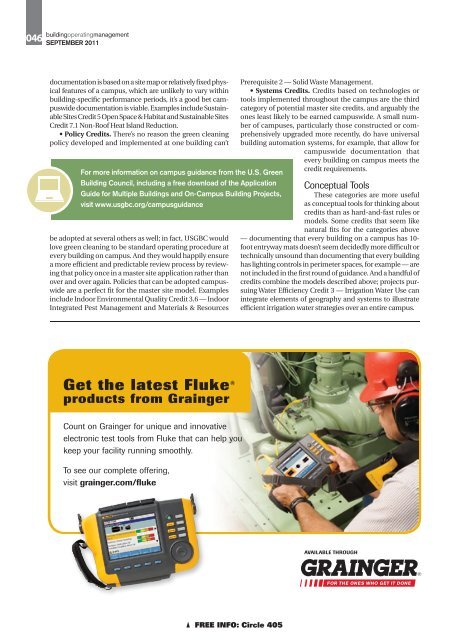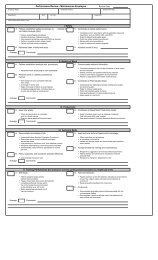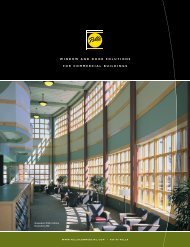Building Operating Management September 2011 - FacilitiesNet
Building Operating Management September 2011 - FacilitiesNet
Building Operating Management September 2011 - FacilitiesNet
Create successful ePaper yourself
Turn your PDF publications into a flip-book with our unique Google optimized e-Paper software.
046<br />
buildingoperatingmanagement<br />
SEPTEMBER <strong>2011</strong><br />
documentation is based on a site map or relatively fixed physical<br />
features of a campus, which are unlikely to vary within<br />
building-specific performance periods, it’s a good bet campuswide<br />
documentation is viable. Examples include Sustainable<br />
Sites Credit 5 Open Space & Habitat and Sustainable Sites<br />
Credit 7.1 Non-Roof Heat Island Reduction.<br />
• Policy Credits.There’s no reason the green cleaning<br />
policy developed and implemented at one building can’t<br />
For more information on campus guidance from the U.S. Green<br />
<strong>Building</strong> Council, including a free download of the Application<br />
Guide for Multiple <strong>Building</strong>s and On-Campus <strong>Building</strong> Projects,<br />
visit www.usgbc.org/campusguidance<br />
be adopted at several others as well; in fact, USGBC would<br />
love green cleaning to be standard operating procedure at<br />
every building on campus. And they would happily ensure<br />
a more efficient and predictable review process by reviewing<br />
that policy once in a master site application rather than<br />
over and over again. Policies that can be adopted campuswide<br />
are a perfect fit for the master site model. Examples<br />
include Indoor Environmental Quality Credit 3.6 — Indoor<br />
Integrated Pest <strong>Management</strong> and Materials & Resources<br />
Prerequisite 2 — Solid Waste <strong>Management</strong>.<br />
• Systems Credits. Credits based on technologies or<br />
tools implemented throughout the campus are the third<br />
category of potential master site credits, and arguably the<br />
ones least likely to be earned campuswide. A small number<br />
of campuses, particularly those constructed or comprehensively<br />
upgraded more recently, do have universal<br />
building automation systems, for example, that allow for<br />
campuswide documentation that<br />
every building on campus meets the<br />
credit requirements.<br />
Conceptual Tools<br />
These categories are more useful<br />
as conceptual tools for thinking about<br />
credits than as hard-and-fast rules or<br />
models. Some credits that seem like<br />
natural fits for the categories above<br />
— documenting that every building on a campus has 10-<br />
foot entryway mats doesn’t seem decidedly more difficult or<br />
technically unsound than documenting that every building<br />
has lighting controls in perimeter spaces, for example — are<br />
not included in the first round of guidance. And a handful of<br />
credits combine the models described above; projects pursuing<br />
Water Efficiency Credit 3 — Irrigation Water Use can<br />
integrate elements of geography and systems to illustrate<br />
efficient irrigation water strategies over an entire campus.<br />
Get the latest Fluke ®<br />
products from Grainger<br />
Count on Grainger for unique and innovative<br />
electronic test tools from Fluke that can help you<br />
keep your facility running smoothly.<br />
To see our complete offering,<br />
visit grainger.com/fluke<br />
▲ FREE INFO: Circle 405





